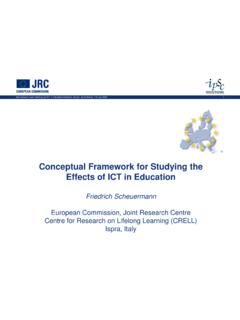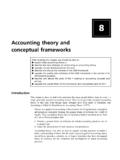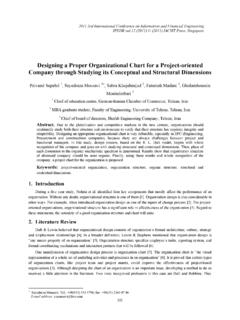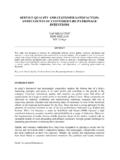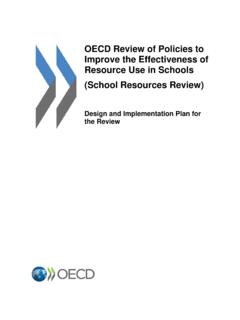Transcription of CHAPTER 1 THE PROBLEM AND ITS BACKGROUND - PEAK …
1 CHAPTER 1. THE PROBLEM AND ITS BACKGROUND . This CHAPTER includes the introduction, theoretical framework , statement of the PROBLEM , hypothesis, scope and limitation, conceptual framework , significance of the study and the definition of terms used. Introduction Researchers focused much of their attention in studying the importance of Intelligence Quotient (IQ) and Emotional Quotient (EQ) because of the thought that these two are important determinants of success. But few years back, Dr. Paul G. Stoltz introduced another concept which talks about how well a person was able to cope, handle and withstand adversities, to recover from those adversities and to turn them into opportunities. This concept is called Adversity Quotient (AQ ).
2 By understanding the concept of AQ we can better understand how we and others react to challenge and adversity in all aspects of our lives. In fact, how people respond to adversity is a strong indicator of ability to succeed in many endeavors (http://stitchestm. ). As Adversity Quotient tells how an individual withstand adversity and his ability to surmount it and it predicts who gives up and who prevails. Adversity Quotient is the measure on how an individual respond in a given situation. Also, 1. Adversity Quotient determines whether an individual will stand strong and true when faced with adversity or the person will be crippled or destroyed (Stoltz, 1999). Today, most people are faced with different adversities. This is the reason why there are organizations that offer help to those who are in need of it.
3 For students, most especially the freshmen who are experiencing the difficulty of the transition from high school to college, they are also given some guidance by the school through mentoring programs. Facing their new environment would mean facing challenging and different obstacles in their career. But how do they face some difficult situations that come up during their adolescent years? What would be the impact of these conflicting demands to their day-to-day life? How would these young people respond in different adversities? Adolescence, defined in books, as the transition period that links childhood and adulthood (Davis et al. 2004). Erikson described it as a moratorium, a temporal and psychological gap between the security of childhood and the autonomy of adulthood (Santrock, 2003).
4 Adolescents are prone to peer pressure that can great influence or impact to their attitudes, values, and behaviors. According to Mendoza (2005), peer group is a contributory factor to an adolescent. This gives strong motivation for gaining social learning. He starts to associate with people. This social relationship with his group forms strong bonding among them. This peer group influences his behavior and decision. And the fact that adolescents are prone to social pressure and conflicting demands, 2. the administration of First Asia Institute of Technology and Humanities (FAITH). formed the mentoring program that is in connection to the mission and vision statement of the Institution. The Institute launched the mentoring program to provide the students with guidance as they face the challenges of college life.
5 Initially it was for Education students then the program has been expanded to include all the courses. Faculty members act as mentors to each student to check his or her academic performance, to help resolve concerns and generally oversee the development of the student as an individual and a true professional. ( ). Mentoring is defined, an off-line help by an individual to another person in making significant transitions in work, knowledge or thinking. This mentoring programs aims to help the freshmen overcome the adversities that college life adjustment brings (Ara o & Panganiban, 2006). In light with the increasing popularity of mentoring during the past decades, the researchers conducted this study to find out whether the mentoring program provided for the freshmen college students at FAITH has a positive effect on the students' Adversity Quotient.
6 The researchers came up with the idea of conducting the present study because of the fact that students are faced with conflicting demands and pressures from school, from their parents, from their peer group, and from the society (Corey, 2004). For freshmen students, all of these demands are present plus the fact that they are experiencing the hardships of college life adjustments. In this regard, the researchers thought of 3. measuring the effect of mentoring program on the freshmen students at FAITH in terms of how they withstand and overcome different adversities. Theoretical framework The concept of mentoring has been around for a long time and stems from Homer's Odyssey. Mentoring is now looked at as a promising approach for enriching children's lives ( ).
7 According to George Herbert Mead's theory of social learning, children begin to perceive themselves from the perspective of the generalized other, the community as a whole. Knowing the norms and values of society, children can begin to know how their actions are perceived by the generalized other. Mead said that everyone has an I and a me. The I is the individual or the true self and the me is the way one acts in different social situations under the norms of society. Through social interaction people learn the acceptable me . Mead felt that children develop their selves through social interaction. Children begin to pattern their selves after a role model ( ). This theoretical framework can be applied to the thesis that mentoring has positive effects on children.
8 The mentor acts as the generalized other and serves as a role model to the student who begins to imitate the mentor. This then reflects the positive effect of mentoring. The student changes his/her me to conform to the norms of society, and the mentor is the role model whom the 4. student uses to pattern his/her me ( ). Erikson believed that personality develops in a series of stages and described the impact of social experience across the lifespan (http://www. ). During adolescence, children are exploring their independence and developing a sense of self ( ). They explore different possibilities for career, interests, friends, etc. At this age, adolescents are trying different behaviors and values from what they have learned at home ( ).
9 Those adolescents who receive proper encouragement and reinforcement through personal exploration will emerge from this stage with a strong sense of self and a feeling of independence and control. Those who remain unsure of their beliefs and desires will insecure and confused about themselves and the future ( ). They are trying to define themselves separate from their parents, although, in the end, most adolescents adopt many of their parents' same values and behaviors as well as unique views of their own ( ). According to Erikson, our ego identity is constantly changing due to new experience and information we acquire in our daily interactions with others. In addition to ego identity, Erikson also believed that a sense of competence also 5.
10 Motivates behaviors and actions ( personality/ ). During this stage also, adolescents may feel the pressure of the conflicting demands on which they are faced. Because of these pressures, adolescents often feel helpless from the adversities they encounter. The learned helplessness theory of Martin Seligman explained why many people give up or stop short when faced with life's challenges. For this reason, this theory is the most significant ingredient in the formation of AQ . Likewise, it is considered by the American Psychological Association as the Landmark Theory of the Century (http://stitchestm. ). Statement of the PROBLEM The study focused on the Effects of Mentoring Program on Adversity Quotient of Selected Freshmen College Students of First Asia Institute of Technology and Humanities during the Second semester of Academic Year 2008.

